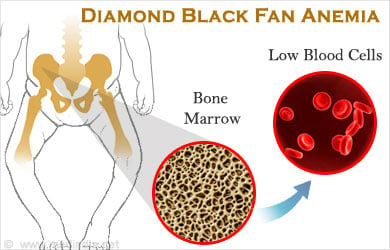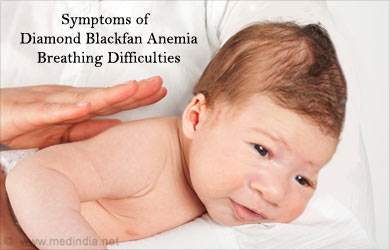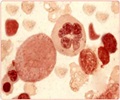What is Diamond Blackfan Anemia?
It occurs when the bone marrow does not make sufficient red blood cells necessary for carrying oxygen from the lungs to other parts of the body. This makes the patient severely anemic. This kind of anemia is not due to insufficiencies in iron, vitamin B12, folate or erythropoietin. DBA is a life-threatening condition leading to other potential abnormalities. DBA affects approximately 5 to 7 per million live born infants worldwide.

Inheritance of Diamond Blackfan Anemia
Nearly 45% of DBA patients inherit the mutation from either of the affected parent. Some DBA patients present new mutations in the gene in families with no history of DBA.
Causes of Diamond Blackfan Anemia
Most people with DBA have mutations in the ribosomal protein gene. There are 12 genetic mutations linked to DBA. In rare cases, a mutation in a gene called GATA-1 is responsible for DBA in boys. GATA-1 is responsible for the earliest steps in red blood cell production.
Symptoms of Diamond Blackfan Anemia
Sometimes DBA presents itself in older children and adults. Symptoms include:
- Pale skin
- Low energy
- Fatigue
- Breathing difficulties

Some of the physical characteristics of DBA include:
- Short stature
- Microcephaly (small head size)
- Low frontal hairline
- Ptosis (drooping eyelids)
- Broad, flat bridge of the nose
- Small, low-set ears
- Micrognathia (small lower jaw)
- Neck and shoulder abnormalities
- Triphalangeal thumb and thenar muscle hypoplasia
People with DBA also present with cardiac and kidney defects. Eye problems such as cataracts, glaucoma and strabismus are not uncommon. Genitourinary abnormalities often occur in males.
Diagnosis/Testing of Diamond Blackfan Anemia
Other genetic anemias like Thalassemia and Fanconi’s anemia need to be ruled out. Since a total of 13 genes (including GATA-1) are linked to DBA, mutations in nearly 55% of DBA patients are detectable through genetic sequencing of 9 genes.
Laboratory findings include:
- Increased mean corpuscular volume (MCV)
- Elevated erythrocyte adenosine deaminase activity (eADA)
- Increased hemoglobin F (HbF) concentration (fetal hemoglobin)
Tests used to diagnose DBF include:
- Blood profile: complete blood count (CBC)
- Bone marrow aspiration and biopsy: obtaining a marrow sample via aspiration and needle biopsy under local anesthesia. Bone marrow aspiration involves removing a fluid specimen from the marrow. Needle biopsy involves removing marrow cells.
- Genetic sequencing
Treatment for Diamond Blackfan Anemia
Treatment options for DBA include:
- Corticosteroid therapy – which is used in children above 12 months. This can improve the red blood cell count. The usual steroid is prednisone. Steroids act as bone marrow stimulants. Low doses are maintained to avoid side effects.
- Blood transfusion therapy – used when anemia is severe and the individual does not respond to steroids.

- Hematopoietic stem cell transplantation (HSCT) – is the only curative for DBA. HSCT involves transplanting a person’s healthy stem cells. This is not an easy option for most people. The success rate depends on a number of factors including matching factors (matched siblings, complete tissue match).
Individuals with DBA are usually evaluated by haematologists, clinical geneticists, cardiologists, nephrologist and urologist (as required) and medical genetics counsellors. A multidisciplinary approach is critical to manage DBA and keep secondary complications in check.
Prevention of Secondary Complications
Individuals need to be assessed for iron overload in order to begin iron chelation therapy.
Measurements for iron overload include:
- Serum ferritin – a blood test used to determine iron levels in the blood. This is not always reliable and often does not correspond with total body iron load.
- Liver biopsy - to measure iron concentration (invasive procedure).
- MRI to evaluate iron load in the heart and liver.
- Magnetic biosusceptometry (SQUID) - measuring iron concentration in the liver.
Iron chelation therapy to remove iron from the body needs to begin after 10-12 blood transfusions. The available options include:
- Deferasirox – usually for individuals above the age of 2. This is an oral drug administered once a day. Usually 20-30mg/kg/day. Side effects include mild rash and nausea. Individuals have to be monitored for creatinine elevation. Regular CBC and liver function tests are necessary.
- Desferioxamine – nocturnal subcutaneous infusion administered 4-7 nights a week through an 8-12 hour infusion through a portable pump.
Regular screening for related cancers is recommended for individuals with DBA.







